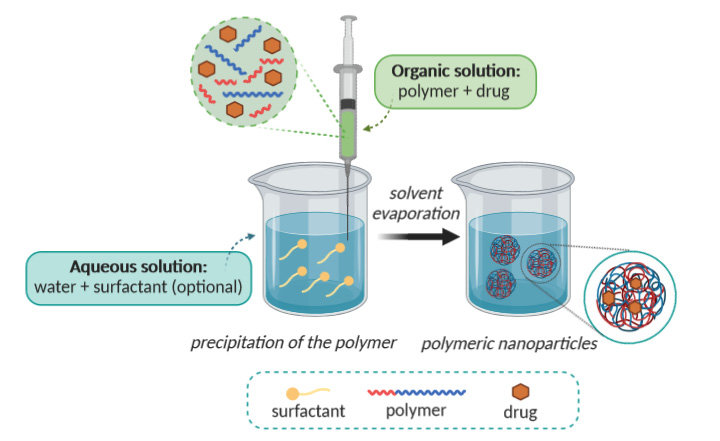Nanoprecipitation: A Versatile Method for Nanoparticle Synthesis
What is Nanoprecipitation?
Nanoprecipitation, also known as solvent displacement or interfacial deposition, is a widely used method for the synthesis of nanoparticles. It involves the precipitation of a dissolved material from a solution into a non-solvent, resulting in the formation of nanoparticles. This technique is particularly useful for preparing polymeric nanoparticles, but it can also be applied to other materials such as lipids and inorganic compounds.

Principle of Nanoprecipitation
The principle behind nanoprecipitation is based on the rapid desolvation of a dissolved material when it encounters a non-solvent. The process involves three main steps:
- Solubilization: The material to be precipitated (e.g., polymer, drug) is dissolved in a solvent, forming a homogeneous solution.
- Mixing: The solution is then rapidly mixed with a non-solvent, which is miscible with the solvent but in which the material has low solubility. This sudden change in solubility causes the precipitation of the material.
- Stabilization: The precipitated nanoparticles are stabilized by surfactants or other stabilizing agents present in the non-solvent, preventing their aggregation and growth.
The size and morphology of the resulting nanoparticles can be controlled by adjusting various parameters, such as the concentration of the materials, the ratio of solvent to non-solvent, the mixing conditions, and the type and concentration of stabilizing agents.
Advantages of Nanoprecipitation
Nanoprecipitation offers several advantages over other nanoparticle synthesis methods:
- Simplicity: The process is relatively simple and does not require complex equipment or harsh reaction conditions.
- Versatility: Nanoprecipitation can be applied to a wide range of materials, including polymers, lipids, and inorganic compounds.
- Mild conditions: The method is carried out at room temperature and does not involve the use of high temperatures or pressures, making it suitable for heat-sensitive materials.
- Scalability: Nanoprecipitation can be easily scaled up for large-scale production of nanoparticles.
Applications of Nanoprecipitation
Nanoprecipitation has found numerous applications in various fields, including:
Drug Delivery
Nanoprecipitation is widely used for the preparation of polymeric nanoparticles loaded with drugs, proteins, or nucleic acids. These nanoparticles can improve the solubility, stability, and bioavailability of the encapsulated drugs, enabling targeted delivery and controlled release.
Imaging and Diagnostics
Nanoparticles synthesized by nanoprecipitation can be used as contrast agents for various imaging techniques, such as magnetic resonance imaging (MRI), computed tomography (CT), and fluorescence imaging. These nanoparticles can be functionalized with targeting ligands for specific detection of diseases or cellular structures.
Catalysis
Nanoprecipitation can be used to prepare metal or metal oxide nanoparticles with high catalytic activity. These nanoparticles can be used in various catalytic applications, such as chemical synthesis, environmental remediation, and energy conversion.
Challenges and Future Perspectives
Despite the many advantages of nanoprecipitation, there are still some challenges that need to be addressed. One of the main challenges is the control over the size distribution and morphology of the nanoparticles. Further research is needed to develop strategies for fine-tuning the properties of nanoparticles prepared by nanoprecipitation.
Future perspectives in nanoprecipitation include the development of novel materials and formulations for specific applications, such as stimuli-responsive nanoparticles for drug delivery and multifunctional nanoparticles for theranostics. The combination of nanoprecipitation with other techniques, such as microfluidics and 3D printing, may also open up new possibilities for the fabrication of complex nanostructures and devices.
Further Reading
International Journal of Pharmaceutics, Nanoprecipitation process: From encapsulation to drug delivery
International Journal of Food Properties, Nano- and Micro-Particles by Nanoprecipitation: Possible Application in the Food and Agricultural Industries
